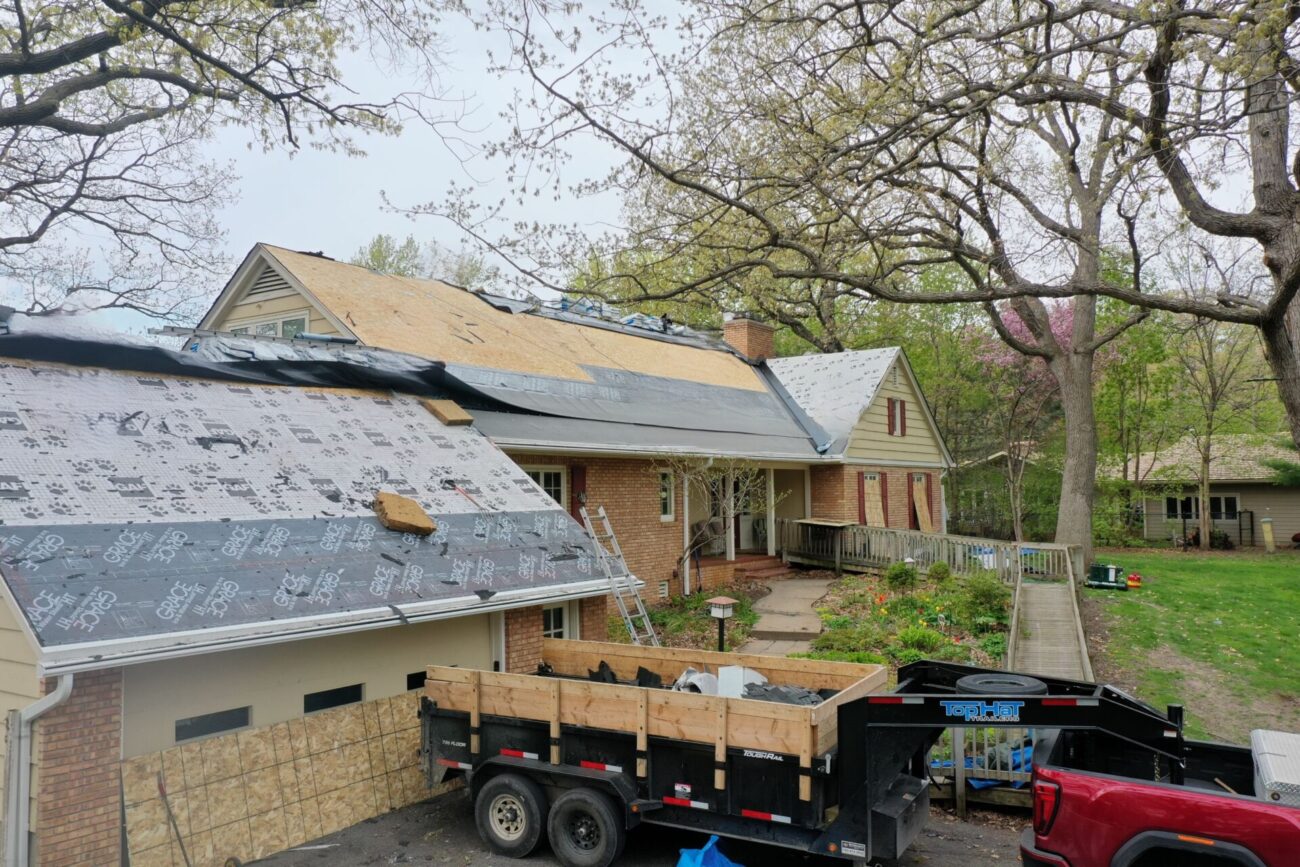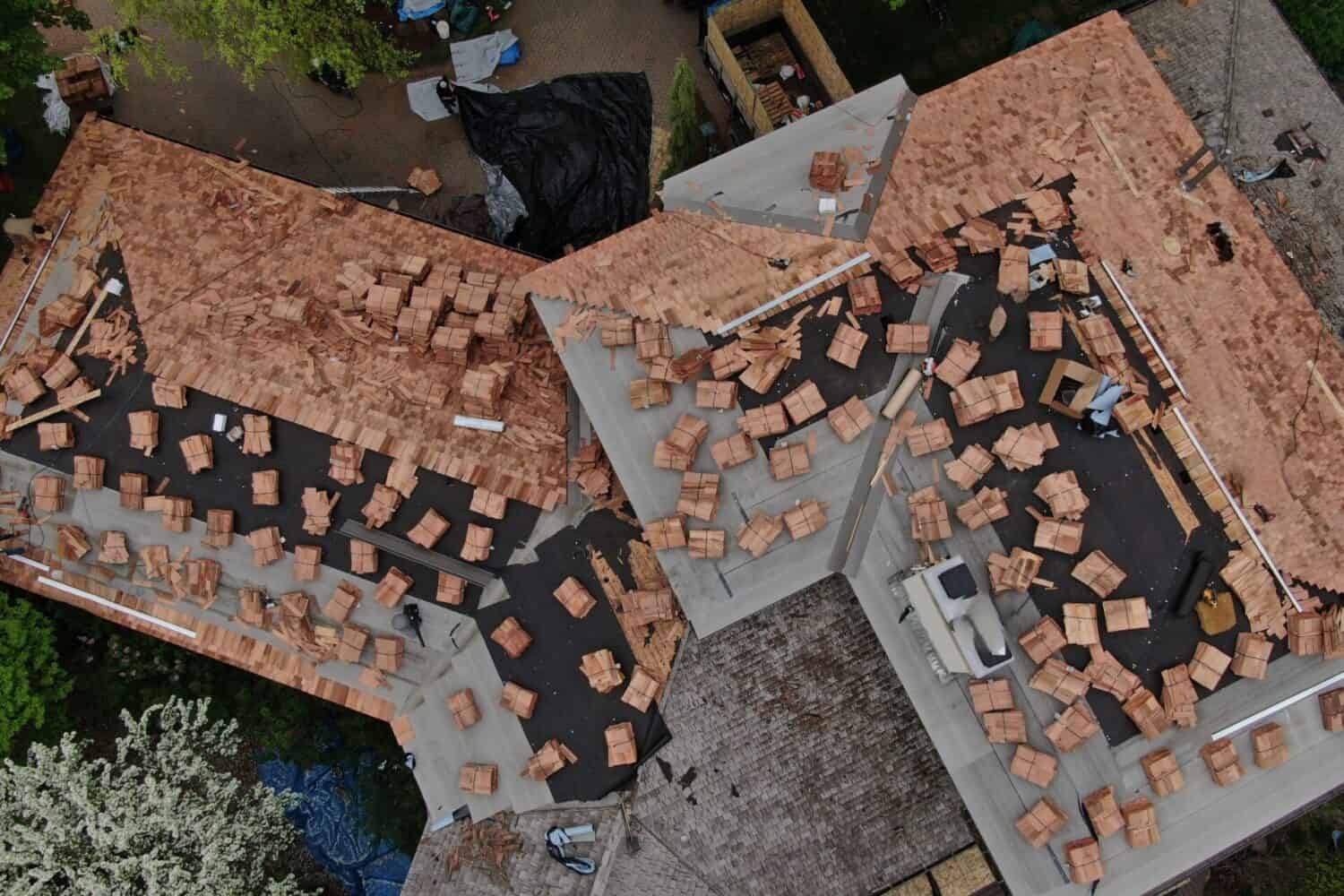Your roof is one of the most important structural elements of your home. A good roof plays a crucial role in protecting your home and adds to its aesthetic appeal, but no roof lasts forever. Sooner or later, you will need to update it so it will keep doing the job it was built to do. When the time comes, there are options. One option is a roof overlay and the other is a full tear off and replacement. Having options though begs the question, between a roof overlay vs tear off, which is the best option? That answer depends on several factors. Let’s take a look at these factors so you can make an informed decision on what’s best for you in the roof overlay vs tear off choice.
What is a Roof Overlay Vs a Tear Off?
Before knowing how to weigh between a roof overlay vs tear off, it is important to understand what each one is.
What is a Roof Overlay?
A roof overlay is just that. It is laying a second set of shingles over your current roofing shingles. This process is sometimes also called a reroof.
A Quick Overview of a Roof Overlay
When installing a roof overlay, your roofing technician will start by removing ridge caps and any other obstructions, such as air vents and pipe flashings. The next step will be to repair any broken, torn, or cracked shingles. The roofer will then sweep the roof clean of any excess debris. The goal is for the roof to be as flat and clear as possible before installing the second set of shingles directly over the existing ones. If the roof is not reasonably flat, gaps will exist between the first and second layer of shingles, which could create problems down the road. Your roofer will install new flashing before cutting and installing the new set of shingles directly on top of your old ones. New air vents and flashing will most likely also be installed. The time it takes to complete the overlay process depends on the size of your roof, but on average, it can be completed in a day or two.
What is a Roof Tear Off?
A roof tear off can more accurately be called a roof tear off and replacement. It is a two-step process of tearing off the existing shingles and replacing them with new ones. A tear off also includes repairing or replacing the roof decking and adding any extra insulation and underlayment. This does not happen with an overlay.
A Quick Overview of the Tear Off and Replacement Process
A roof tear off is a multi-step process that does not just replace your shingles but gets underneath them and updates your decking too. This is a much more thorough process than an overlay.
Your contractor will first completely remove all the old roofing materials and then will go over your existing roof section by section using special tools. This will also include any old components, such as underlayment, flashing, and vents. After the tearing off your old roof, your contractors will inspect the overall condition of the wood decking. This gives the contractor a chance to see any damage or potential problems with the decking and replace it before installing the new roofing shingles. Once the decking is ready, your roofer will install your new shingles section by section until you have your new roof. Your tear off and replacement also includes your contractor cleaning up, hauling away, and disposing of your old roofing materials. The tear off and replacement process takes longer than an overlay, but on average can be completed anywhere between a few days to a little over a week.
Now that you know what each side of the roof overlay vs tear off option is, let’s dig a little deeper into the pros and cons of each one.
The Pros and Cons of a Roof Tear Off
Whenever you decide to do a home repair or improvement, there are many decisions you need to make. Your home is one of the biggest investments you will make in your life, so weighing your options before taking on a repair project is always a sound way to go. There are both pros and cons to look at when it comes to roof removal and replacement.
The Pros
Repair the Problem
A roof tear off means you get down to the roof decking, which gives your roofer a chance to see exactly what shape it is in. If it needs repair, it gets done during the replacement process. This makes a roof tear off and replacement a much more thorough and complete way to maintain your roof.
Choose Different Materials
If you are looking to change the aesthetics of your roof, a full tear off and replacement is the way to go. It gives you a chance to choose any number of roofing materials, from slate and wood shakes to solar shingles. Looking at a reroof vs tear off, your choice of roofing materials is hands down better with a tear off.
Pay for Longevity
A full roof replacement, depending on the materials you choose to use, can last anywhere between 20-50 years. The longevity you buy up front with a full roof tear off and replacement makes for a long-term investment in maintaining the structure and aesthetics of your home. This is most likely one of the biggest considerations in the roof overlay vs tear off debate.
The Cons
Pay the Price
The price to tear off and replace a roof is always going to be higher than a roof layover. It takes longer and involves more work for your roofer, which in turn raises the labor cost. The price of a new roof also depends on your roof’s structure, how many slopes you have, the materials you use, and if there is any roof damage that needs to be repaired, especially to the decking. These factors matter in the cost of a full roof replacement.
Clean the Mess
Tearing the roof off your home is a messy business. A professional, reputable roofing company will clean up the mess after they are done tearing off the roof and replacing it. Still, in the meantime, your old roof surrounds your property along with dumpsters and debris. Cleaning up the mess also costs money, which adds to the overall cost of the job, including both labor and disposal fees.
 The Pros and Cons of a Roof Overlay
The Pros and Cons of a Roof Overlay
Just as there are pros and cons to a roofing tear off and replacement, there are pros and cons to a roof overlay as well. Understanding these pros and cons is important when looking at a roof overlay vs tear off.
The Pros
Time, Money and Mess
Since you don’t tear off shingles in a roof overlay, there is much less mess than in a tear off and replacement. This fact also means it takes a lot less time to do a roof overlay than a full replacement. Less mess and less time also adds up to less initial cost for roof overlay. This combination of less time, money, and mess is the biggest pro on the side of a reroof in the roof overlay vs tear off choice.
The Cons
No Full Inspection
As mentioned above, a full roof inspection is only possible by tearing off your old roofing materials. If there is no tear off, there is not full inspection. It is difficult to catch a problem if you can’t see the problem. With an overlay, problems can be missed. If these problems are not fixed, they can lead to bigger problems later on.
Decreased Home Value
In the roof overlay vs tear off debate, an overlay can be seen as more of a quick fix option. This can be seen as decreasing your home value. A buyer may see it as a liability since eventually they will have to pay for a more expensive replacement. This could make your home more difficult to sell and put a lower price tag on it overall.
No Choice on Shingle Type
A roof overlay can only be done with asphalt shingles. If you have asphalt shingles and want to use a different type of shingle for your reroof, you do not have that option. It is also true that if you currently have a shingle other than asphalt, you do not have the option of doing a roof overlay. You have to do a full tear off and replacement. You can only overlay asphalt shingles with asphalt shingles.
Lots of Extra Weight
Roofing materials are heavy by design. An overlay inevitably adds more weight to your roof because you are adding an extra set of shingles on top of what you already have. This can overload your roof and compromise its integrity, causing possible problems later, including roof collapse.
Higher Long-Term Costs
The extra layer of shingles added with a roof overlay can make fixing leaks difficult, complicated and costly. Not replacing the underlayment can also lead to more complicated and costly damage down the line. In addition, sooner or later, you will have to replace your roof. With two layers of shingles, the eventual roof tear off will be twice as messy and twice as long, which adds up to being costlier as well. A roof overlay may have a smaller price tag up front, but in the long run that price tag can get much larger.
Roof Overlay Vs Tear Off: Which Should You Choose?
If you are deciding between a new roof vs an overlay roof, you do want to weigh your particular roofing circumstances. These include:
- Age of the roof
- Type of shingles
- Current condition of the roof
- Long-term considerations
If your roof is nearing the end of its life, but the underlayment and shingles are still in fairly good condition, a roof overlay may be a good option. It can also be an option if your roof is still in good shape, but you want to change the color or design for less money than a replacement.
If you already have two layers of shingles on your home, you cannot do a roof overlay though. Two layers is as many as most building codes will allow.
If your roof is older and showing signs of damage, your best option is most likely going to be a tear off. Otherwise you are just kicking the can down the road and could be causing more damage that will ultimately cost you more money in the long run.
The Last Word: Call a Professional Before You Decide
When looking at a roof overlay vs tear off for your home, it is always a good idea to get a professional roof inspection done. A professional knows what to look for during an inspection and will be able to give you valuable insight into the specifics of your roof. No home repair project is simple, but getting it done right is important, especially when it comes to protecting your home and valuing how it looks. Before deciding between a roof overlay vs tear off, bring in a roofing professional.

